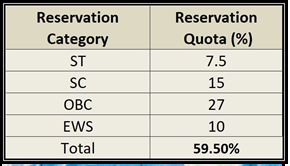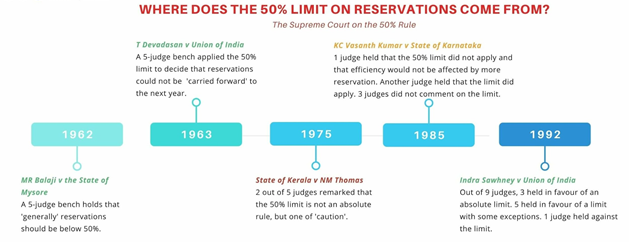ON RESERVATIONS AND THE OBC CREAMY LAYER
Relevance: GS 2 – Government policies and interventions for development in various sectors and issues arising out of their design and implementation.
Why in the news?
- The allotment of Indian Administrative Service (IAS) to Puja Khedkar as an Other Backward Class (OBC) Non-Creamy Layer (NCL) candidate.
- The candidate also has multiple disabilities.
- This case has raised issues surrounding the creamy layer in OBC reservation.
Recommendations of the Mandal Commission
Reservation in Government Jobs and Educational Institutions:
- 27% reservation for OBCs in central government services and public sector undertakings.
- The Same 27% Reservation in educational institutions for OBCs.
Criteria for Identifying OBCs:
- Social, educational, and economic indicators to determine backwardness.
- Use of caste as the primary indicator of social backwardness.
Implementation of Welfare Measures:
- Various measures to enhance the educational and economic status of OBCs.
History of Reservation in India
- Constitutional Provisions:
- Articles 15 and 16 guarantee equality to all citizens in government policies and public employment.
- Special provisions for the advancement of socially and educationally backward classes (OBC), Scheduled Castes (SC), and Scheduled Tribes (ST).
- Reservation for SCs and STs: 15% reservation for SCs and 7.5% reservation for STs.
- Applicable in jobs, educational institutions, and public sector undertakings (PSUs) at the central level.
- Implementation of OBC Reservation: In 1990, Prime Minister V. P. Singh implemented 27% reservation for OBCs in central government employment based on Mandal Commission (1980) recommendations.
- Expansion to Educational Institutions: In 2005, reservation was extended to OBC, SC, and ST in educational institutions, including private institutions.
- Reservation for Economically Weaker Sections (EWS): In 2019, 10% reservation was introduced for the Economically Weaker Sections (EWS) among the unreserved category.
The Creamy Layer
- Supreme Court Ruling on OBC Reservation:
- The 27% reservation for OBC was upheld by the Supreme Court in the Indra Sawhney case (1992).
- The court opined that caste is a determinant of class in the Indian context.
- To uphold the basic structure of equality, the court fixed a cap of 50% for reservation, unless there are exceptional circumstances.
- The court also provided for the exclusion of the creamy layer from OBC reservations.
- The 27% reservation for OBC was upheld by the Supreme Court in the Indra Sawhney case (1992).
- Criteria for Identifying the Creamy Layer:
- Based on the recommendations of the Justice Ram Nandan Prasad Committee (1993).
- Determined by the position/income of an applicant’s parents alone.
- Income Criteria: Parental income, excluding income from salary and agricultural income, should be more than ₹8 lakh in each year in the last three consecutive financial years.
- Additional Criteria for Creamy Layer:
- Parents, either of whom entered government service (centre or State) as Group A/Class I officers or parents, both of whom entered as Group B/Class II officers or father, who was recruited in Group B/Class II post and promoted to Group A/Class I before 40 years of age.
- Either of the parents employed in a managerial position in PSUs.
- Either of the parents holding constitutional posts.
Issues Surrounding Reservation
- Inadequacies in the Process:
- Allegations of some applicants obtaining Non-Creamy Layer (NCL) or Economically Weaker Sections (EWS) certificates through dubious means.
- Similar issues may exist with respect to disability certificates, enabling misuse of the 4% reserved seats for persons with disabilities in central government jobs.
- Evasion of Creamy Layer Exclusion:
- Allegations of applicants and their parents adopting strategies to bypass creamy layer exclusion, such as:
- Gifting of assets.
- Taking premature retirement.
- Since the applicant’s or spouse’s income is not considered for exclusion, these tactics can be used to maintain eligibility.
- Allegations of applicants and their parents adopting strategies to bypass creamy layer exclusion, such as:
- Concentration of Reservation Benefits:
- The Rohini Commission has estimated that 97% of reserved jobs and seats in educational institutions have been secured by just around 25% of the OBC castes/sub-castes at the central level.
- Close to 1,000 out of approximately 2,600 OBC communities had zero representation in jobs and educational institutes.
- Similar issues of concentration exist within the SC and ST categories, where there is no exclusion based on the creamy layer.
- High Percentage of Reservation:
- Reservation currently stands at 60%, including EWS reservation, reflecting societal realities and the need for higher reservation percentages.
- Government replies in Parliament indicate that 40-50% of seats reserved for OBC, SC, and ST in the central government remain unfilled.
Way Forward
- Plugging Loopholes: Implement thorough scrutiny in the issuance of NCL, EWS, and disability certificates.
- Ensure only eligible applicants obtain these benefits.
- Filling Reserved Vacancies: Address the backlog and fill vacancies for reserved communities promptly.
- Sub-Categorisation of Reservation: Implement sub-categorisation to address the under-representation or non-representation of various communities within OBC, SC, and ST categories.
- Consideration of Creamy Layer Exclusion for SC and ST: Explore the possibility of creamy layer exclusion for SC and ST categories, particularly for children of Group I/Class A government officials.
- Initiating Dialogue: Begin discussions with all stakeholders on these sensitive matters.
- Weigh arguments and counterarguments to ensure a balanced approach.
- Ensuring Equitable Distribution:
- Ensure that the benefits of reservation reach the more marginalised among the underprivileged in successive generations.
- Implement measures to make the reservation system more effective and equitable.
Alternative articles
https://universalinstitutions.com/clarification-on-de-reservation-policy/
Mains question
Critically analyze the challenges and potential solutions for equitable distribution of reservation benefits in India, focusing on issues related to the creamy layer, sub-categorization, and certificate fraud. (250 words)





